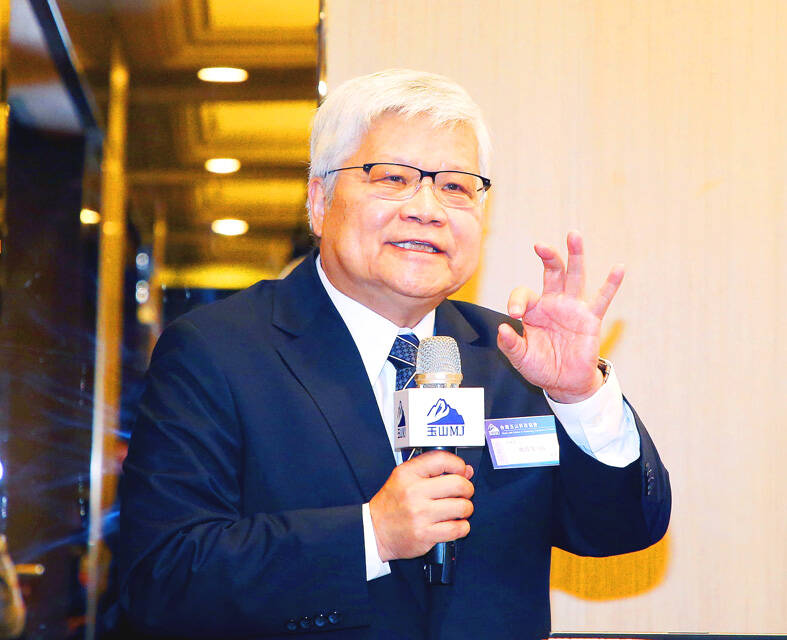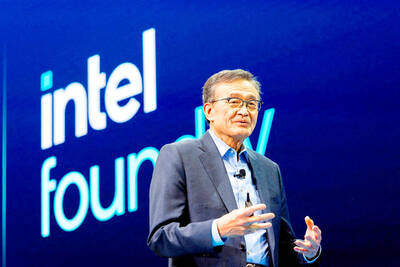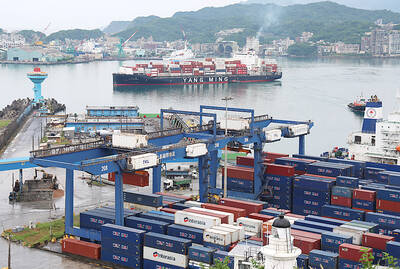There is “no chance” that building a wafer fab would necessarily create a technical advantage over other semiconductor manufacturing sites, Taiwan Semiconductor Manufacturing Co (TSMC, 台積電) chief executive officer C.C. Wei (魏哲家) said on Saturday, amid concerns that Taiwan could gradually lose its competitive edge in the industry due to rising global competition.
Wei made the remarks during a speech on challenges facing the semiconductor industry at a forum held by Monte Jade Global Science and Technology Association in Taipei.
The possible “de-Taiwanization” of the semiconductor industry has been widely discussed after TSMC announced plans earlier this month to build a second fab in Arizona equipped with 3-nanometer processes in addition to its first fab for which it held a tool-in ceremony on Dec. 6.

Photo: CNA
The US and Japan have tightened restrictions on exports of advanced microchips and chip manufacturing equipment to China, which would pose challenges for China’s semiconductor production, he said.
The situation is likely to be exacerbated by COVID-19 outbreaks in China, he said.
Geopolitics, the COVID-19 pandemic and Russia’s invasion of Ukraine have made semiconductors more crucial than ever, and every country wants to have the capability to make them, he said.
The easiest step in building an industry chain is to purchase machinery, but technology does not come with the construction of plants, he said.
After a manufacturer acquires the technology, it must learn how to produce, which is a skill that needs to be acquired, he said.
Semiconductor design involves “brainwork,” but there is a shortage of engineers in most countries, he said.
These factors mean that there is “no way” that any country could dominate the industry just by building fabs, he said.
TSMC has enjoyed moderate success due to its collaborative efforts with its subcontractors, he said. “Money can build you production lines, but won’t take you much further than that,” he said. “So does building a plant mean offshoring an entire industry? The answer is no,” he said.
Commenting on the current challenges facing the semiconductor industry, he said that the industry was no longer advancing as quickly at the pace defined by Moore’s law, a phenomenon he attributed to the extreme costs involved in semiconductor production.
“One machine equipped with extreme ultraviolet lithography costs 200 million euros [US$211.9 million], and one fab needs 20 to 30 of them,” he said.
“Those who want to enter semiconductor production, be my guest,” he added.
Responding to a question about his views on Japan’s plan to form a “semiconductor alliance” to develop technology for manufacturing 2-nanometer wafers, Wei said it was “not impossible for a business or a country to take shortcuts in semiconductor manufacturing, but it would be difficult.”
Asked what motivated TSMC to build a fab equipped with 22-nanometer and 28-nanometer processes in Japan, Wei said it has a client in Japan that happens to be a supplier of TSMC’s largest client.
Customers’ needs, not the needs of Washington or Tokyo, are always TSMC’s main consideration when it decides whether to set up a fab, he said.
The company must give its Japanese partner its full support to ensure that the production schedule of its largest client is not affected, otherwise it could have repercussions for TSMC’s 3-nanometer fabs, he said.
TSMC’s financial statements show that its biggest client, which is widely believed to be Apple Inc, contributed NT$405.4 billion, or 26 percent, of its revenue last year.
Asked about Berkshire Hathaway Inc’s recent acquisition of a large amount of TSMC’s stock, Wei said that it had motivated him to also increase his shares in the company.

CHIP RACE: Three years of overbroad export controls drove foreign competitors to pursue their own AI chips, and ‘cost US taxpayers billions of dollars,’ Nvidia said China has figured out the US strategy for allowing it to buy Nvidia Corp’s H200s and is rejecting the artificial intelligence (AI) chip in favor of domestically developed semiconductors, White House AI adviser David Sacks said, citing news reports. US President Donald Trump on Monday said that he would allow shipments of Nvidia’s H200 chips to China, part of an administration effort backed by Sacks to challenge Chinese tech champions such as Huawei Technologies Co (華為) by bringing US competition to their home market. On Friday, Sacks signaled that he was uncertain about whether that approach would work. “They’re rejecting our chips,” Sacks

NATIONAL SECURITY: Intel’s testing of ACM tools despite US government control ‘highlights egregious gaps in US technology protection policies,’ a former official said Chipmaker Intel Corp has tested chipmaking tools this year from a toolmaker with deep roots in China and two overseas units that were targeted by US sanctions, according to two sources with direct knowledge of the matter. Intel, which fended off calls for its CEO’s resignation from US President Donald Trump in August over his alleged ties to China, got the tools from ACM Research Inc, a Fremont, California-based producer of chipmaking equipment. Two of ACM’s units, based in Shanghai and South Korea, were among a number of firms barred last year from receiving US technology over claims they have

Taiwan’s exports soared 56 percent year-on-year to an all-time high of US$64.05 billion last month, propelled by surging global demand for artificial intelligence (AI), high-performance computing and cloud service infrastructure, the Ministry of Finance said yesterday. Department of Statistics Director-General Beatrice Tsai (蔡美娜) called the figure an unexpected upside surprise, citing a wave of technology orders from overseas customers alongside the usual year-end shopping season for technology products. Growth is likely to remain strong this month, she said, projecting a 40 percent to 45 percent expansion on an annual basis. The outperformance could prompt the Directorate-General of Budget, Accounting and

BARRIERS: Gudeng’s chairman said it was unlikely that the US could replicate Taiwan’s science parks in Arizona, given its strict immigration policies and cultural differences Gudeng Precision Industrial Co (家登), which supplies wafer pods to the world’s major semiconductor firms, yesterday said it is in no rush to set up production in the US due to high costs. The company supplies its customers through a warehouse in Arizona jointly operated by TSS Holdings Ltd (德鑫控股), a joint holding of Gudeng and 17 Taiwanese firms in the semiconductor supply chain, including specialty plastic compounds producer Nytex Composites Co (耐特) and automated material handling system supplier Symtek Automation Asia Co (迅得). While the company has long been exploring the feasibility of setting up production in the US to address